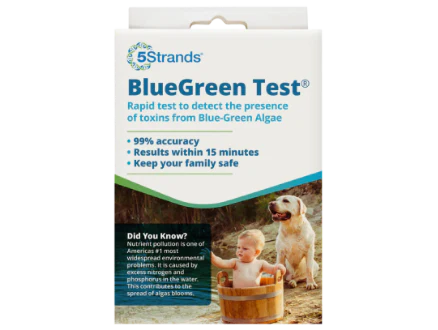Over the summer many families like to enjoy water sports at their local body of water. Upon arrival you might be greeted with signs telling you to stay out of the water as blue green algae might be present.
What is Blue Green Algae? Is it dangerous for my dog? For me?

Blue green algae (otherwise known as cyanobacteria) has been present on earth for billions of years. Cyanobacteria was the first photosynthetic organism on earth whose job is to change the atmosphere to provide oxygen allowing life as we know it to exist. Cyanotoxins are released into the environment by active secretion and through passive leakage as cyanobacteria die, disintegrate, and spill their internal contents. When cyanobacteria rapidly reproduce under favorable conditions, they inevitably exhaust nutrient sources and experience a steep die-off. These die-offs are behind the sudden release of cyanotoxins that poison the water. In a toxic bloom, there can be multiple species of cyanobacteria, each producing different variants of cyanotoxins. These toxins are harmful to humans and pets when contaminated water is swallowed (either intentionally or during recreation).
The three major classes of cyanotoxins are:
- Microcystin - Microcystin (produced by Dolichospermum (previously Anabaena), Fischerella, Gloeotrichia, Nodularia, Nostoc, Oscillatoria, members of Microcystis, and Planktothrix) is the most common cyanotoxin, with between 251,000 variants. Upon ingestion of toxic water, microcystin primarily damages the liver but can also harm kidneys and reproductive systems.
- Cylindrospermopsin - Cylindrospermopsin produced by Raphidiopsis (previously Cylindrospermopsis), raciborskii (C. raciborskii), Aphanizomenon flos-aquae, Aphanizomenon gracile, Aphanizomenon ovalisporum, Umezakia natans, Dolichospermum (previously Anabaena) bergii, Dolichospermum lapponica, Dolichospermum planctonica, Lyngbya wollei, Rhaphidiopsis curvata, and Rhaphidiopsis mediterranea) similarly affects the liver and the kidneys but does so by inhibiting protein synthesis.
- Anatoxin - Anatoxin, on the other hand, is a neurotoxin which leads to paralysis and rapid death. These toxins are mainly associated with the cyanobacterial genera Chrysosporum (Aphanizomenon) ovalisporum, Cuspidothrix, Raphidiopsis (previously Cylindrospermopsis), Cylindrospermum, Dolichospermum, Microcystis, Oscillatoria, Planktothrix, Phormidium, Dolichospermum (previously Anabaena) flos-aquae, A. lemmermannii Raphidiopsis mediterranea (strain of Raphidiopsis raciborskii), Tychonema and Woronichinia. One variant of anatoxin is colloquially known as the ‘Very Fast Death Factor.’ Whereas microcystin and cylindrospermopsin are very stable in aquatic environments, anatoxin is fortunately very volatile, degrading rapidly with light exposure and as a result is uncommon in toxic blooms.
Causes of Cyanobacterial Blooms:
However with recent global warming and the increased usage of phosphates in runoff… we have created the perfect storm.
Toxic algae blooms are caused by a combination of:
- Water Temperature
- Light
- Excess nutrients (such as phosphorus, nitrogen) in the water
- Phosphorus and nitrogen that are found in animal and human wastes and in fertilizers.
- Fertilizer runoff into brooks, streams and creeks, which make its way into rivers and lakes. After a rainstorm, phosphorus from industrial fertilizers can be swept into lakes and rivers, leading to massive blooms. Careful management practices, such as diversion of runoff away from water sources and decreased use of industrial fertilizer, can reduce the occurrence of toxic blooms.

In a blink of any eye cyanobacteria has gone from providing life’s essentials to being toxic to humans and pets.
Does the body of water matter?
Cyanobacteria in river systems offer a different challenge, as different species are adapted to deal with flowing water. To escape the current in rivers, river-based cyanobacteria form mats with algae at the bottom of river beds. When the riverbed is disrupted by an increase in flow, the cyanobacterial-algae mats detach and wash to the shoreline. Once in the warm, light-filled shallows of the river shoreline, the cyanobacteria can grow quickly in relatively stagnant water. Cyanotoxins are released into the water near the shore by both actively toxin-secretion and dead or ruptured cyanobacteria. When cyanotoxins are found in rivers, lake-based methods of bloom management can exacerbate the duration of toxic blooms. The sudden increase in water current from flushing a river can detach other river-bed cyanobacteria-algae mats, leading to a repeat of the cycle. Instead, the best method to both prevent and remedy river-based toxic blooms is to increase base flow of river water through the warmer months when cyanobacteria growth is favorable to prevent the formation of mats.

How do you identify blue green algae in the water?
Often the water may have a blue-green color with a slime on the surface. Some people say it resembles pea soup. There can be blooms on the surface to indicate a problem. Blooms sometimes look like foam, scum, mats, or paint on the surface of the water. They can even make the water appear in different colors, including green, blue, red, brown, or another color. However, the scariest part of this is that the water can appear clean and still be toxic.
This is where 5Strands Affordable Testing comes in. The BLUEGREEN TEST® is the world's first rapid diagnostic test to detect a broad range of hepatotoxins on-site. It utilizes a single step, sandwich type, non-competitive immunocomplex assay method, using combinations of antibodies detecting molecular structures present in all common microcystins and nodularins. This combination enables the test to detect eleven commonly occurring hepatotoxins in a single test and can detect levels below 0.1 µg/L. and takes just 15 minutes to process with immediate, sensitive and indicative results.

Can the toxins become airborne?
For the first time recorded (2021), scientists have observed the release of blue-green algae toxins into the air. Traces of the algal toxin anatoxin-a, or ATX, sometimes called the Very Fast Death Factor, were measured at a Massachusetts pond that frequently hosts large algal blooms. ATX is produced by cyanobacteria, a type of photosynthesizing bacteria. Though not technically algae, cyanobacteria is often called blue-green algae. Scientists aren't sure how exactly the toxins are becoming airborne, whether the ATX molecules are enveloped in aerosolized water droplets or attaching themselves to other aerosolized particles. They said that it's also possible the cyanobacteria cells themselves are becoming airborne. No matter how it's happening, researchers say the phenomenon is a threat to the health and safety of humans and wildlife. People and animals (including pets, livestock, and wildlife) can get sick when they have contact with water or food that contains certain types of algae, cyanobacteria, or their toxins. People and animals can get sick if they swim, wade, or play in or near contaminated water, eat contaminated fish, shellfish, or simply use contaminated drinking water. Illnesses and symptoms can vary depending on how a person or animal was exposed (came into contact with algae, cyanobacteria, or their toxins), how long they were exposed, which type of toxin was present, and how much toxin was present. Symptoms can include stomach pain, vomiting, or diarrhea , general symptoms, like headache, skin, eye, nose, or throat irritation and neurological symptoms (for example, muscle weakness, dizziness). Exposure to some algae and cyanobacterial toxins can also harm your liver and kidneys. The CDC is currently working on a study about the airborne dangers.
Human Health Effects
When people are exposed to cyanotoxins, adverse health effects may range from a mild skin rash to serious illness or in rare circumstances, death. Acute illnesses caused by short-term exposure to cyanobacteria and cyanotoxins during recreational activities include hay fever-like symptoms, skin rashes, respiratory and gastrointestinal distress. Exposure to drinking water contaminated with elevated concentrations of microcystin and cylindrospermopsin could cause liver and kidney damage. The table below summarizes the health effects caused by the most common toxin-producing cyanobacteria.
|
Cyanotoxins
|
Acute Health Effects in Humans
|
Most Common Cyanobacteria Producing Toxin
|
|
Microcystin-LR
|
Abdominal pain, headache, sore throat, vomiting and nausea, dry cough, diarrhea, blistering around the mouth, and pneumonia
|
Microcystis, Dolichospermum (previously Anabaena), Nodularia, Planktothrix, Fischerella, Nostoc, Oscillatoria, and Gloeotrichia
|
|
Cylindrospermopsin
|
Fever, headache, vomiting, bloody diarrhea
|
Raphidiopsis (previously Cylindrospermopsis) raciborskii, Aphanizomenon flos-aquae, Aphanizomenon gracile, Aphanizomenon ovalisporum, Umezakia natans, Dolichospermum bergii, Dolichospermum lapponica, Dolichospermum planctonica, Lyngbya wollei, Rhaphidiopsis curvata, and Rhaphidiopsis mediterranea
|
|
Anatoxin-a group
|
Tingling, burning, numbness, drowsiness, incoherent speech, salivation, respiratory paralysis leading to death (experimental animals)
|
Chrysosporum (Aphanizomenon) ovalisporum, Cuspidothrix, Raphidiopsis, Cylindrospermum, Dolichospermum, Microcystis, Oscillatoria, Planktothrix, Phormidium, Dolichospermum flos-aquae, A. lemmermannii Raphidiopsis mediterranea (strain of Raphidiopsis raciborskii), Tychonema and Woronichinia
|
Is There Treatment For Exposure?
For people that come into contact with contaminated water, it is recommended that you rinse off as quickly as possible. If you are experiencing any symptoms that are listed above, you will need to seek immediate medical attention.
If your pet has been exposed to a harmful algae bloom, you will want to rinse them off immediately. Monitor for symptoms and seek immediate veterinarian help. For most pets, exposure can be deadly.
The only sure way to know is to test the waters. No, we don't expect you to drag lab equipment out to the shoreline. However, 5Strands Affordable Testing has brought an easy and new test to market that can detect the toxins in the water. No more guesswork, and no more taking chances on your or your pet’s life.


























